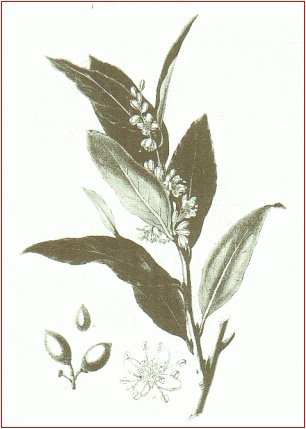
Laurus nobilis
Sweet Bay
USD 1926 Part II
Compiled and edited by Ivor Hughes
Laurus nobilis L. Sweet Bay. Laurier commun Fr. Lorbeer, G.
The sweet bay is an evergreen tree of the Fam. Lauraceae, inhabiting the countries bordering on the Mediterranean.
It produces yellow flowers in early spring and later succulent, purple berries.
The leaves are alternate; on short petioles, ovate - lanceolate or oblong, entire, pellucid - punctate, of a firm texture, smooth, shining, deep green upon their upper surface, paler beneath.
They have a fragrant odor, especially when bruised, and a bitter, aromatic, somewhat astringent taste..
They yield by distillation a greenish-yellow volatile oil which contains pinene, phellandrene, cineol, 1 - linalool, geraniol, eugenol and methyl. eugenol; also acetic, isovaleric, and isobutyric acids and esters.
The sp. gr. is 0.915 - 0.930; Opt. Rab. - 15� to - 22�; ref. ind. 1.4670 to 1.4775; acid number 1 to 3 and ester number 20 to 50.
The volatile oil, of which the fruit yields 0.23 per cent., has a sp. gr. 0.88, and is solid at 0� C. (Schim. Rep., April, 1897)
Water distilled from the leaves has their peculiar odor. The berries (Fructus Lauri) when dried are black and wrinkled, and contain two oval fatty seeds within a thin, friable envelope; or they may be considered as drupes, with a kernel divisible into two lobes. They have the same aromatic odor and taste as the leaves, but are more pungent. They contain besides a volatile oil, a fixed oil (Oleum Lauri Expressum) which, as obtained by expression from the fresh fruit, is of a greenish color, and aromatic odor from retained volatile oil.
One of its chief constituents is the glyceryl ester of lauric acid, the so-called laurostearine C3H5 (C12H23O2)3, which fuses at 45� C.
The free acid may be obtained from this by saponification. It cannot be distilled without decomposition.
Another constituent of the crude fat is laurin, C22H30O3, which can be extracted by alcohol. It forms neutral, easily fusible prisms without odor or taste..
Lard, impregnated with the odorous principle of the berries, and colored green by chlorophyll or sometimes by indigo and turmeric, is said to be often substituted for the genuine expressed oil. This may be detected by boiling alcohol, which dissolves the true oil.
The leaves, berries, and oil are excitant and narcotic, but are rarely used internally as medicines, and in this country are scarcely employed in any manner.
E. M. Holmes, however, states that the berries have been used in Europe to promote miscarriages. (P.J. 1910, 352.) Their chief use is to communicate a pleasant odor to external remedies. The leaves are also used for culinary purposes in communicating their aromatic flavor to soups, stews, etc. They come into commerce frequently as the packing around stick licorice extract from Mediterranean countries.
The following is abstracted from, A Modern Herbal. Mrs M. Grieve FRHS

The shrub has been cultivated in Britain since the sixteenth century. It is the source of the ancients' crowns and wreaths for heroes and poets, and the modern term of `bachelor,' given for degrees, is probably derived from bacca - laureus, or laurel-berry, through the French bachelier.
The Delphic priestesses are said to have made use of the leaves. It grows well under the shade of other trees if they are not too close, and is useful in evergreen plantations. The leaves are much used in cookery for flavouring. They are often packed with stick Liquorice or dried figs. They are used fresh, and may be gathered all the year round.
The volatile oil is sometimes used in perfumery. The dried, black, aromatic berries come from Provence, Spain, Italy and Morocco. They are ovoid, and the kernel of the seed is loose.
The wood is sweet-scented, and is used for marqueterie work.
Onguent de Laurier is prepared from the oil with axonge and the colouring and scenting principles of the leaves and fruit.
Constituents. A greenish-yellow volatile oil is yielded by distillation from the leaves which contains a high percentage of oxygenated compounds. The berries contain both fixed -and volatile oils, the former, known as Oil of Bays, includes Zaurostearine, the ether of lauric acid. Laurin can be extracted by alcohol.
A frequent substitute for the expressed oil is said to be lard coloured with chlorophyll or indigo and turmeric, scented with the berries. Boiling alcohol, which dissolves the true oil, will detect this.
The volatile oil contains pinene, geraniol, eugenol, cineol, etc.
Medicinal Action and Uses. Leaves, berries and oil have excitant and narcotic properties. The leaves are also regarded as a diaphoretic and in largo doses as an emetic. Except as a stimulant in veterinary practice the leaves and fruit are very rarely used internally. They were formerly employed in hysteria, amenorrho;a, flatulent colic, etc. The berries have been used to promote abortion.
Oil of Bays is used externally for sprains, bruises, etc., and sometimes dropped into the ears to relieve pain. The leaves were formerly infused and taken as tea, and the powder or infusion of the berries was taken to remove obstructions, to create appetite, or as an emmenagogue. Four or five moderate doses were said to cure the ague. The berries were formerly used in several French carminative preparations.
The following products are often mistaken for those of Laurus nobilis. The fruits of Cocculus Indicus or Anamirta paniculata. They are odourless and kidney shaped.
The oil of Pimenta Acris, from which bay rum is distilled in the West Indies, and which is also called oil of bay.
The leaves of Prunus Laurocerasus, or Cherry Laurel, to which the name of Laurel is now always applied. The margin of these short, strong serrations at intervals. Caution should be observed in distinguishing these, owing to their poisonous properties.
Library
![]()